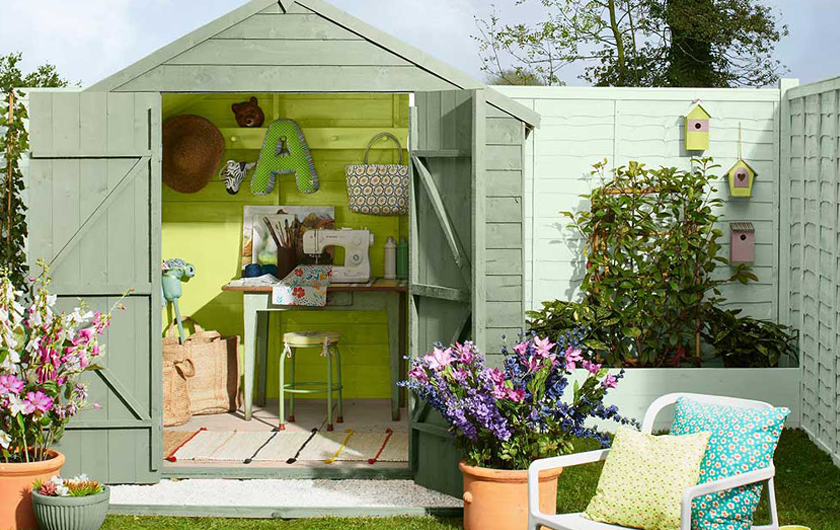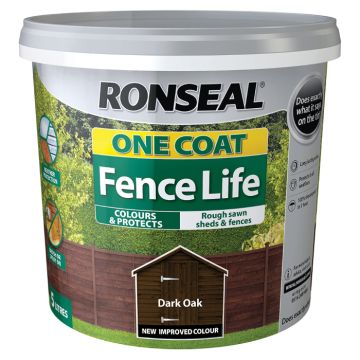
Whether nestled in a corner of your garden or proudly standing at the heart of your garden, a shed is more than just a storage unit. It's a retreat, a workroom, a haven, and, at times, a symbol of our love for gardening. Therefore, its upkeep, particularly repainting, is of the utmost importance. Not only does a fresh coat of paint help maintain its charm, but it also acts as a protective shield against the elements, ultimately extending its longevity.
When it comes to painting your shed, the choice of brand plays a significant role in determining the outcome. Here at PaintWell, renowned brands like Cuprinol shed paint, Ronseal shed paint, and Sadolin shed paint are some of the favourites among our customers, and for good reason. With their rich, durable colours and weather-resistant formulas, these paints ensure that your shed gets the treatment it deserves.
Assessing Your Shed
Before you set out to give your shed a vibrant makeover, it's vital to assess its current state. Look for signs of peeling or faded paint - these are indicators that it's time for a repaint. You might be wondering, "Can I paint over a painted shed?" The answer is yes. However, the key to a flawless paint job lies in the preparation. You must ensure the existing paint surface is adequately prepared to accept the new paint.
Additionally, any wood rot or structural damage should be addressed prior to painting. Paint might cover up the unsightly areas, but it won't resolve underlying issues. If these problems aren't fixed promptly, they can cause significant damage that might require costly repairs in the future. So, before you open that tin of Cuprinol garden shed paint or start applying that vibrant blue shed paint, do make sure that your shed is in a sound structural condition, ready for its transformation.
When to Paint Your Shed
Timing is of the essence when it comes to repainting your garden shed. It's crucial to choose a period when the weather is just right. In the UK, spring and autumn are often considered the best seasons for painting a shed. During these periods, the weather is usually mild, and there's less likelihood of rain or extreme heat, which can interfere with paint application and drying.
In addition to the seasonal timing, it's best to paint on a day when the sun is not directly beating down on your shed, as this can cause the paint to dry too quickly, leading to an uneven finish. So, plan to paint when your shed is in the shade or on a cloudy but dry day.
Choosing the Right Materials
When it comes to selecting the best shed paint, there's a spectrum of options available to suit your taste and the overall aesthetic of your garden. For instance, you might fancy a blue shed paint for a cool, serene look or a white shed paint for a clean, crisp appearance. Alternatively, a sage green shed paint could be your preference if you want your shed to blend seamlessly with the garden surroundings.
On the practical side, we can't overemphasise the benefits of waterproof shed paint. It adds an extra layer of protection against harsh weather conditions, including rain and snow, ensuring your shed stays looking its best for longer. When asked, "What kind of paint do you use to paint a shed?" We always advise considering the British weather and going for something that offers additional protection, like a waterproof variant.
If you're looking to maintain a harmonious look throughout your garden, consider our range of fence and shed paint. One of our top recommendations is the Ronseal fence and shed paint, known for its excellent coverage and durability.
Now, onto the tools: a quality paint job is not just about the paint itself but also the tools used to apply it. Brushes and rollers are the most common tools for painting sheds, each with their unique benefits. So, "Should you paint a shed with a roller or brush?" Well, if your shed has a large, flat surface, a roller would be your best bet as it can cover large areas quickly. For more intricate details and hard-to-reach corners, a brush would be more suitable.
Remember, the key to a successful shed painting project lies in quality materials and proper technique. If you're unsure, our team of experts is always on hand to help you make the right choices.
Preparing Your Shed for Painting
When repainting a shed, preparation is arguably as crucial as the painting itself. It might take a bit of effort, but the results are well worth it. To prepare your shed for repainting, follow these steps:
- Cleaning: Start by cleaning your shed to remove any dirt, moss, or algae. You can do this using a mild detergent and a soft brush. Rinse thoroughly and let it dry completely before moving on to the next step.
- Repairing: Check for any signs of wood rot or damage. Repair these areas as needed to ensure a smooth and stable surface for painting.
- Removing Old Paint: If the existing paint is peeling or flaking off, it's essential to remove it to ensure the new paint adheres correctly. Use a paint scraper, sandpaper, or a heat gun to carefully remove the old paint. "How do you remove old paint from a shed?" Well, the most effective method depends on how much paint needs removing and its condition. For larger areas or stubborn patches, you might need to use a chemical paint stripper.
- Sanding: Once all old paint is removed, sand the surface to create a smooth base for the new paint.
- Priming: "Do you need to prime a shed before painting?" It's not always necessary, but we'd usually recommend it, especially if your shed is bare wood or you're changing the colour drastically. Priming helps to block stains and knots in the wood, prevents peeling, and ensures a uniform colour.
Painting Your Shed
With your shed now prepared, it's time for the exciting part – painting! Here's how you can effectively paint your shed:
- First Coat: Using your chosen tool (brush or roller), apply the first coat of paint. Start at the top of the shed and work your way down, painting in the direction of the grain. Take your time and ensure all areas, including edges and corners, are covered.
- Second Coat: Once the first coat is completely dry, apply a second coat following the same method.
So, "Does painting a shed make it last longer?" Absolutely! Painting acts as a barrier against moisture, rot, and insects, thereby enhancing the longevity of your shed. Plus, it gives your shed a fresh, appealing look.
When it comes to paint longevity, "How long does paint last in a shed?" It varies based on the quality of paint and the conditions the shed is exposed to. However, typically, a good quality paint like Cuprinol garden shed paint or Ronseal shed paint should last about 5 to 10 years.
Wondering "How many litres of paint do I need to paint a shed?" That will depend on the size of your shed and the type of paint. On average, a litre of paint covers about 10 to 12 square metres with one coat. For a medium-sized shed, you might need about 3 to 5 litres of paint for two coats. If you're unsure, consult with our experts for an accurate estimate.
Don't forget, the colour of your shed paint plays a crucial role in defining your garden's aesthetics. Brands like Cuprinol offer an exciting range of shed paint colours that allow you to express your unique style.
Conclusion
Taking care of your shed is an investment, not only in your garden's aesthetics but also in the longevity of the structure. Regular maintenance and painting are crucial steps in preserving your shed's charm and functionality over the years. A fresh coat of paint can do wonders in revitalising your garden retreat, keeping it weather-resistant and visually appealing.
As you embark on your shed painting journey, we invite you to explore the variety of shed paint options available. Whether you're looking for a delicate cream shed paint to create a serene garden haven or a bold red shed paint for a standout feature, the possibilities are endless. Maybe a forest green shed paint is more your style, allowing your shed to blend naturally into your garden surroundings. Or perhaps you prefer the classic sophistication of black shed paint. Whichever colour you choose, remember that the quality of the paint is just as important as the hue.
At PaintWell, we're fortunate to have access to a wide variety of top-quality shed paints. Brands like Ronseal, Cuprinol and Sadolin offer excellent shed paints that are designed to withstand our often unpredictable weather while providing a beautifully smooth finish. So take your time, enjoy the process, and remember that our team of experts is here to help you every step of the way.
Giving your shed a new coat of paint can be a rewarding project, breathing new life into your garden and extending the life of your shed. After all, your shed is more than just a storage space; it's a part of your home. Treat it with the care it deserves.

